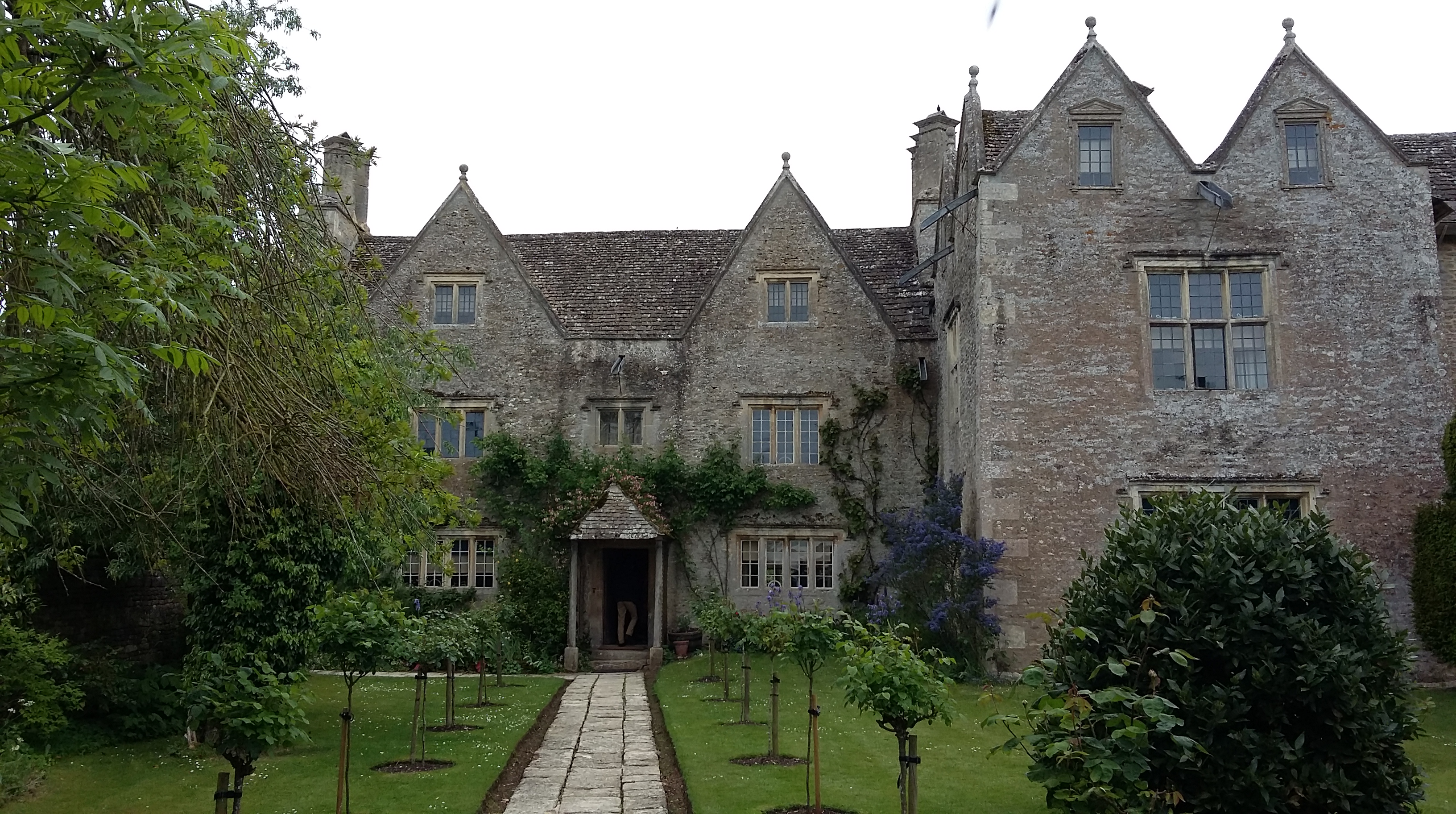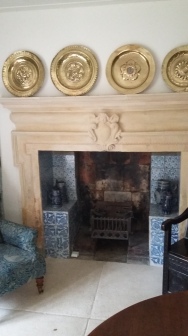 It is surprising that I’ve never been to Kelmscott Manor before, but this week I went with a group from the Birmingham Midland Institute. I gave a lecture about William Morris while we were travelling, so I spent the preceding week deeply immersed in Morris’s life and work, and it has increased my passion for him. Visiting Kelmscott consequently felt like something of a pilgrimage. The Manor has an interesting history anyway, dating from 1600, and Morris felt that it was “the loveliest haunt of ancient peace”, which seemed to be rooted in the soil and the people who had lived there. The image of Kelmscott is particularly famous for its appearance as the frontispiece for Morris’s utopian novel News from Nowhere, and it was wonderful to see it in the stone, as it were, and to feel the deep peace which the place exudes.
It is surprising that I’ve never been to Kelmscott Manor before, but this week I went with a group from the Birmingham Midland Institute. I gave a lecture about William Morris while we were travelling, so I spent the preceding week deeply immersed in Morris’s life and work, and it has increased my passion for him. Visiting Kelmscott consequently felt like something of a pilgrimage. The Manor has an interesting history anyway, dating from 1600, and Morris felt that it was “the loveliest haunt of ancient peace”, which seemed to be rooted in the soil and the people who had lived there. The image of Kelmscott is particularly famous for its appearance as the frontispiece for Morris’s utopian novel News from Nowhere, and it was wonderful to see it in the stone, as it were, and to feel the deep peace which the place exudes.
Morris was fascinated by the medieval period, ideas and ideals as well as aesthetics, since his childhood when he rode around on a pony in his suit of miniature armour and made up stories in the woods about knights, ladies and fairies. As he grew up, rejecting the Church as a profession in favour of architecture while he was at Oxford, his thoughts and ideas all seem to stem from this childhood interest. Books influenced him deeply; he’d apparently read all of Walter Scott’s novels by the age of nine, and at University he discovered Thomas Carlyle’s Past and Present, John Ruskin’s The Stones of Venice and Charlotte Yonge’s The Heir of Redclyffe. What these books all share, I think, is dissatisfaction with the industrial, self-seeking present, and a desire to revisit the past which is more than nostalgia, but a genuine desire to put right what they felt was wrong with the world. Like the modern-day knight of Yonge’s novel, Guy Morville, Morris’s life demonstrates how he lived out the ideals he developed as a young man.
Morris is mostly remembered as a designer, now, and of course there are many of his designs at Kelmscott Manor, which is perhaps more simply furnished than one might  expect, but in a distinctive style (I’ve now discovered why my parents painted all their furniture dark green) with natural, clear colours. Many of the fabrics and objects there were brought there after his death, but it’s wonderful to see his bed, with the poem he wrote for it embroidered by Jane around it, which begins:
expect, but in a distinctive style (I’ve now discovered why my parents painted all their furniture dark green) with natural, clear colours. Many of the fabrics and objects there were brought there after his death, but it’s wonderful to see his bed, with the poem he wrote for it embroidered by Jane around it, which begins:
The wind’s on the wold
And the night is a-cold,
And Thames runs chill
‘Twixt mead and hill.
Morris’s poetry, his Norse tales, his Socialist work and his designs all demonstrate a remarkable sense of unity. Though his Socialism developed after he encountered Marx’s Das Kapital, he was always anxious for opportunities for all, and for a fairer system to be achieved in Britain, for which he was quite prepared for violent anarchy – indeed, he felt it was probably the only way, and in News from Nowhere it is apparent that such a revolution had occurred. His desire was  not only for equality but for dignity and respect for all, and that comes in a very Marxist form in News from Nowhere, where all receive the same pay and love their work. The guiding principal of ‘The Firm’ which Morris set up to produce useful and beautiful household objects was that art should be handmade, using the skill of the craftspeople, and that all should have access to it. Of course these things may seem improbable or even impossible, and Morris is nothing if not an idealist, but there is something incredibly appealing about his beautiful, medievalized utopia in which all can share in the beauty of life through art, nature and love. The environment was an important part of this, too: how we connect to what is around us – buildings, places, the natural world – indicates who were are, and it is very clear what he thought of the pollution and destruction of the natural environment in the nineteenth century:
not only for equality but for dignity and respect for all, and that comes in a very Marxist form in News from Nowhere, where all receive the same pay and love their work. The guiding principal of ‘The Firm’ which Morris set up to produce useful and beautiful household objects was that art should be handmade, using the skill of the craftspeople, and that all should have access to it. Of course these things may seem improbable or even impossible, and Morris is nothing if not an idealist, but there is something incredibly appealing about his beautiful, medievalized utopia in which all can share in the beauty of life through art, nature and love. The environment was an important part of this, too: how we connect to what is around us – buildings, places, the natural world – indicates who were are, and it is very clear what he thought of the pollution and destruction of the natural environment in the nineteenth century:
Is money to be gathered? cut down the pleasant trees among the houses, pull down ancient and venerable buildings for the money that a few square yards of London dirt will fetch; blacken rivers, hide the sun and poison the air with smoke and worse, and it’s nobody’s business to see to it or mend it: that is all that modern commerce, the counting-house forgetful of the workshop, will do for us herein.
He is remarkably prescient, I believe: I’ve been reading Naomi Klein’s This Changes Everything: Capitalism vs. the Climate recently, and Morris’s views that we have lost connection with the environment, that we are wreaking havoc on the wo rld and there will be ecological payback, and that capitalism in the form of industrialised society is the main driver of climate destruction are echoed vividly in Klein’s arguments. Wandering the beautiful gardens at Kelmscott, and walking beside the Thames where Rossetti and Morris wandered, one can see why he felt so strongly about this, leaving behind the polluted rivers and skies of London.
rld and there will be ecological payback, and that capitalism in the form of industrialised society is the main driver of climate destruction are echoed vividly in Klein’s arguments. Wandering the beautiful gardens at Kelmscott, and walking beside the Thames where Rossetti and Morris wandered, one can see why he felt so strongly about this, leaving behind the polluted rivers and skies of London.
Morris said that ‘History has remembered the kings and warriors, because they destroyed; art has remembered the people, because they created.’ To be creative was the source of life for Morris, and Kelmscott Manor provided the peace that he needed for this. He wrote in the late 1870s of sitting in the tapestry room one evening, watching the sun set over the fields and hearing the cows lowing in the pasture; there are still cows there, and it is possible to feel very close to the past here.







Leave a comment